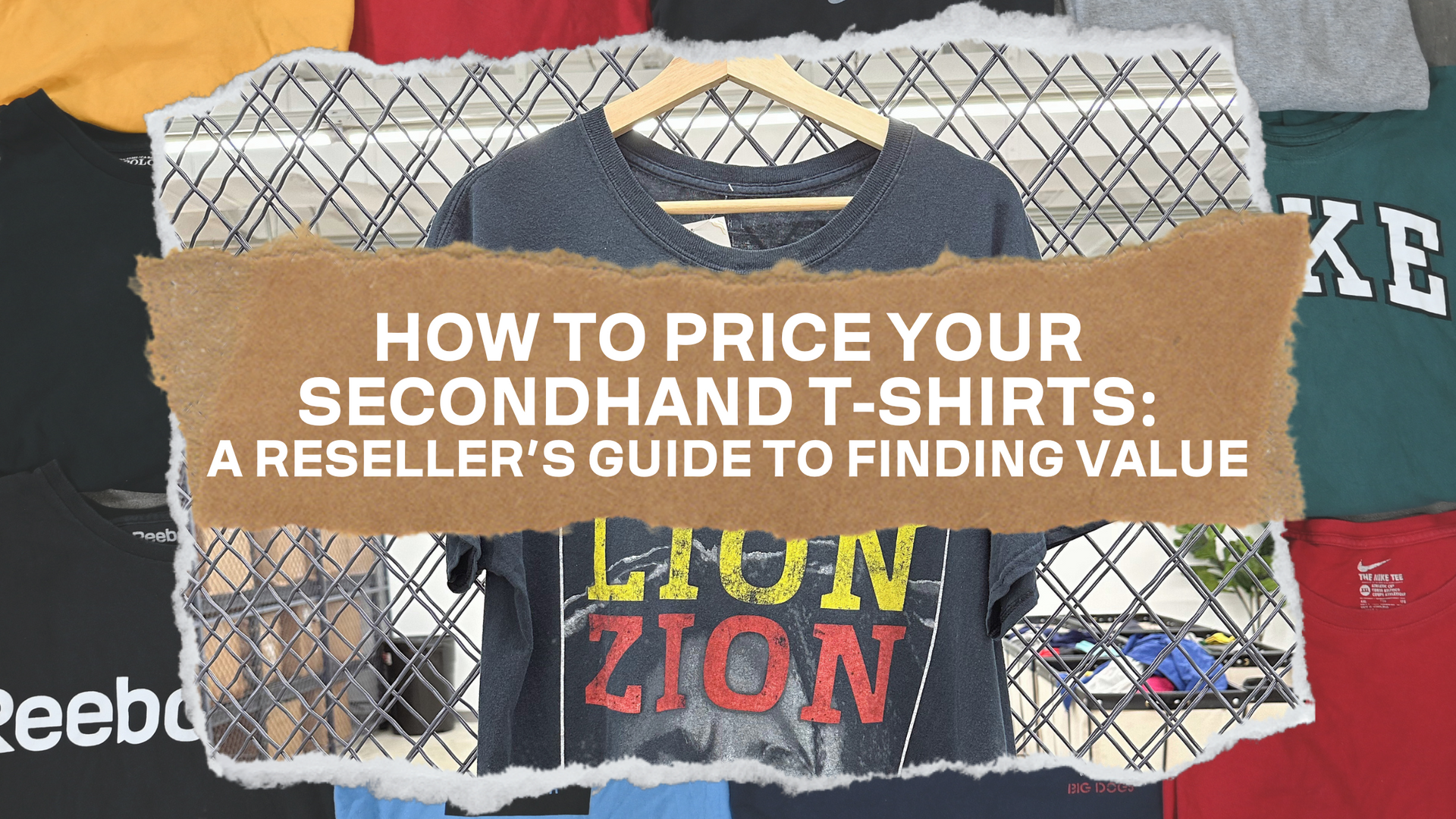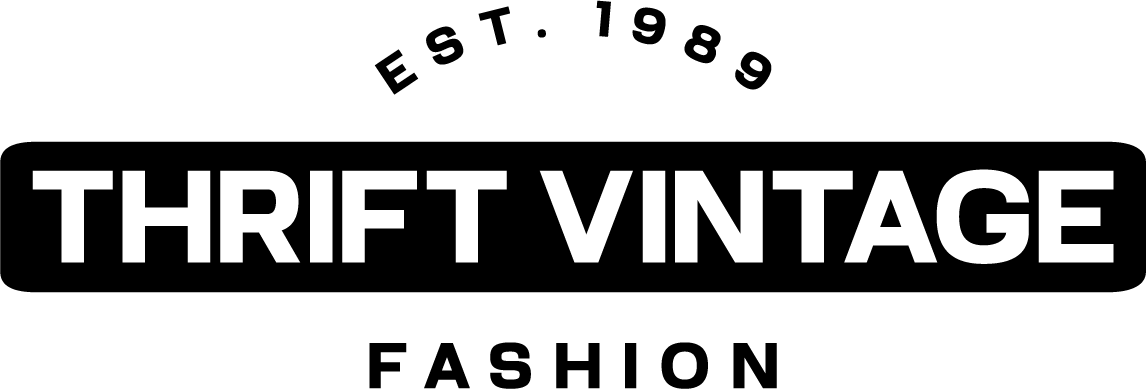
How to Price Your Secondhand T-Shirts: A Reseller’s Guide to Finding Value
If you're reselling secondhand t-shirts, understanding how to price them correctly is key to making a profit while keeping your inventory moving. Whether you're flipping vintage tees or modern graphic shirts, knowing the worth of your pieces can set you apart as a successful reseller.
This guide will walk you through how to evaluate a t-shirt’s value based on key factors like brand, condition, rarity, and demand. At the end, you'll find a 10-point checklist to help you confidently price your inventory.
1. Brand & Label: Who Made It and When?
A t-shirt’s brand can heavily influence its value, especially in the vintage market. Some brands are highly sought after, while others may not hold much resale appeal.
What to Look For:
-
Vintage Labels – If you come across brands like Screen Stars, FOTL (Fruit of the Loom) single stitch, Hanes Beefy-T, Salem Sportswear, or Brockum, you may have a valuable piece.
-
Hype Brands – Shirts from Supreme, BAPE, Stüssy, or old Nike collections often fetch high resale prices.
-
Obscure or Defunct Brands – Some lesser-known brands from the '80s and '90s can be worth money simply because they’re rare.
Pro Tip: Check the tag’s design. If it has a paper tag (instead of printed-on branding), it’s more likely to be older. Certain tag colors and fonts also indicate different eras.
2. Stitching: Single vs. Double Stitch
Single-stitch t-shirts (usually pre-1996) are often more valuable than double-stitch tees because they indicate true vintage status.
How to Check:
-
Look at the hem of the sleeves and the bottom of the shirt.
-
If there’s only one row of stitching, it’s a single-stitch tee (more valuable).
-
If there are two rows, it’s a double-stitch tee (usually newer and less valuable, though some still hold value).
3. Condition: Worn vs. Damaged
T-shirts with minor distressing (light fading, small holes, or fraying) can actually increase value, especially in vintage fashion. However, excessive damage can lower a shirt’s worth.
What’s Acceptable vs. What’s Not?
✅ Desirable Wear – Soft, naturally faded fabric, light cracking on graphics, and minor fraying.
🚫 Bad Wear – Large holes, armpit stains, deep fabric damage, bad odors.
Pro Tip: If a t-shirt has some flaws but is still desirable (like a rare band tee), highlight its "authentic vintage wear" instead of calling it "damaged."
4. Graphics & Prints: The Design Matters
Certain prints and graphics make a t-shirt more valuable. Vintage band tees, promo shirts, and pop culture graphics are especially desirable.
What to Look For:
-
Band Tees – Shirts featuring rock bands (Metallica, Nirvana, Tupac, etc.) can sell for hundreds, even thousands.
-
Movie & TV Tees – Promo tees for cult classics (Pulp Fiction, The Simpsons, Star Wars) hold long-term value.
-
Sports & Event Tees – Super Bowl, Olympics, and wrestling event tees are often collectible.
-
Corporate & Promo Tees – Think old Coca-Cola, Marlboro, or Apple shirts—brands people love.
Pro Tip: If a graphic is screen-printed (not heat-pressed or sublimated), it's often better quality and holds up over time.
5. Age & Era: Older Often Means Rarer
Older shirts, especially those from the '80s and '90s, tend to be more valuable than those from the 2000s. But how can you date a shirt?
How to Tell a Shirt’s Age:
-
Tag Research – Google the brand label to find out what era it belongs to.
-
Stitching – As mentioned earlier, single-stitch usually means pre-'96.
-
Copyright Date – If a shirt has a year printed on the graphic (e.g., "1994 Warner Bros."), that’s usually when it was made.
6. Rarity: The Scarcity Rule
If a shirt is rare (meaning it wasn’t mass-produced or is from a limited run), it’ll typically be worth more.
How to Identify Rare Tees:
-
Tour or Concert Merch – One-time event shirts, especially from smaller venues.
-
Limited Drops – Collabs from brands like Supreme, Nike, or artist-run merch lines.
-
Defunct Brands – Companies that don’t exist anymore (e.g., Liquid Blue, old Stüssy prints).
7. Demand: Trends & Market Influence
A t-shirt’s value isn’t just about age or rarity—it’s about what people want right now. Some vintage shirts were once cheap but have skyrocketed in price due to trends.
What’s Hot Right Now?
-
Y2K Nostalgia – Early 2000s streetwear, rap tees, and sportswear.
-
Band Tees – Classic rock and 90s hip-hop shirts remain high-value.
-
Movie & TV Merch – Retro shows like The Sopranos, The Simpsons, and old anime tees.
Check resale sites like eBay, Grailed, or Depop to see what's trending before pricing your items.
8. Sizing: Bigger is (Usually) Better
Oversized and XL+ sizes are more in demand than smalls and mediums, especially in the streetwear scene.
Why?
-
Many vintage buyers prefer a relaxed or oversized fit.
-
Bigger shirts are harder to find in good condition, making them more valuable.
Pro Tip: If a rare shirt is a small, it might take longer to sell, but a bigger size will likely fetch a higher price.
10 Things to Keep in Mind When Pricing Your Secondhand Inventory
-
Brand & Label – Vintage or hype brand? Look up past sales.
-
Stitching – Single stitch usually means higher value.
-
Condition – Light wear is fine, major damage lowers value.
-
Graphics – Popular band, movie, or promo tees hold long-term value.
-
Age & Era – Older tees, especially pre-2000s, often have more worth.
-
Rarity – Limited-run, tour merch, and event-based shirts are more valuable.
-
Current Trends – What’s hot right now? Check resale markets.
-
Sizing – Bigger sizes (XL+) usually fetch higher prices.
-
Fabric Feel – Soft, well-worn cotton tees are often more desirable than stiff, newer ones.
-
Where You’re Selling – Prices vary by platform (eBay vs. Grailed vs. Instagram).
Final Thoughts
Pricing secondhand t-shirts is part art, part science. By considering brand, rarity, condition, and trends, you can confidently price your inventory to maximize profits.
Want to stock up on vintage and secondhand t-shirts? Check out our inventory of 100+ wholesale categories and stock up fast!
